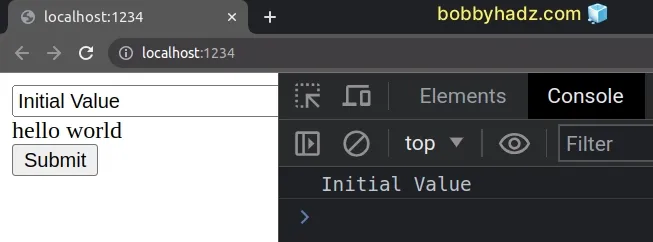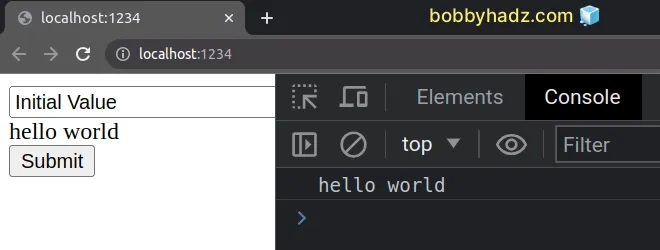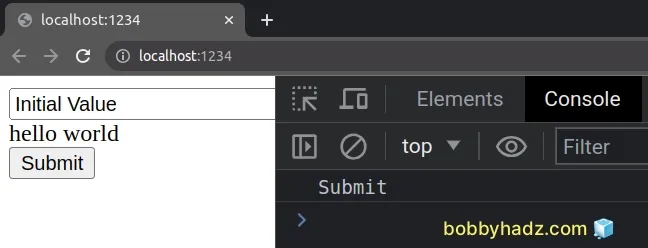How to use document.getElementById() in TypeScript
Last updated: Feb 29, 2024
Reading time·3 min

# How to use document.getElementById() in TypeScript
To use the document.getElementById() method in TypeScript:
- Use a type assertion to type the selected element correctly.
- Use a type guard to make sure the variable doesn't store a
nullvalue. - Access any element-specific properties.
This is the index.html file for the examples.
<!DOCTYPE html> <html> <head> <meta charset="UTF-8" /> </head> <body> <input id="message" type="text" name="message" value="Initial Value" /> <div id="box">hello world</div> <button id="btn">Submit</button> <script src="./src/index.ts"></script> </body> </html>
And here is the related TypeScript code.
const input = document.getElementById( 'message', ) as HTMLInputElement | null; if (input != null) { console.log(input.value); // 👉️ "Initial Value" }

Here is an example of using document.getElementById() to select the div
element.
const box = document.getElementById( 'box', ) as HTMLDivElement | null; console.log(box?.innerHTML); // 👉️ "hello world"

And here is an example that uses the method to select the button element.
const button = document.getElementById( 'btn', ) as HTMLButtonElement | null; if (button != null) { console.log(button.innerText); // 👉️ "Submit" }

The
document.getElementById
method has a return type of
HTMLElement | null.
If no element with the provided id exists in the DOM, the method returns a
null value.
If we have to access any element-specific properties on the variable, we have to use a type assertion to type it correctly
Type assertions are used when we have information about the type of a value that TypeScript can't know about.
input variable stores anHTMLInputElement or a null value and not to worry about it.In the first example, we typed the input variable as
HTMLInputElement | null.
The types are consistently named HTML***Element. Once you start typing
HTML.., your IDE should be able to help you with autocomplete.
Some commonly used types are: HTMLInputElement, HTMLButtonElement,
HTMLAnchorElement, HTMLImageElement, HTMLTextAreaElement,
HTMLSelectElement, etc.
We used a simple if statement as a
type guard to make sure the input
variable doesn't store a null value before accessing properties on it.
const input = document.getElementById('message') as HTMLInputElement | null; // 👉️ input has type HTMLInputElement or null here if (input != null) { // 👉️ input has type HTMLInputElement here console.log(input.value); // 👉️ "Initial Value" }
input variable has a type of HTMLInputElement in the if block and allows us to directly access its value property.It's always a best practice to include null in the type assertion because the
getElementById() method would return null if no element with the provided
id was found.
# Using the optional chaining (?.) operator
You might also use the
optional chaining (?.) operator to
short-circuit if the reference is equal to null or undefined
const box = document.getElementById('box') as HTMLDivElement | null; console.log(box?.innerHTML); // 👉️ "hello world"
The optional chaining operator short-circuits returning undefined if the
reference is equal to null or undefined.
box variable stores a null value, we won't attempt to access the innerHTML property on null and get a runtime error.If you don't use a type assertion with the document.getElementById method, the
type of the variable is going to be HTMLElement | null.
// 👇️ const input: HTMLElement | null const input = document.getElementById('message'); if (input != null) { // ⛔️ Can't access value here console.log(input.value); // 👉️ "Initial Value" }
Since the value property doesn't exist on the HTMLElement type, we aren't
allowed to access it.
This approach is sufficient when you don't have to access any element-specific properties.
I've also written an article on how to use document.querySelector() in TypeScript.
If you need to get the value of an input element in TS, click on the link and follow the instructions.
# Additional Resources
You can learn more about the related topics by checking out the following tutorials:

